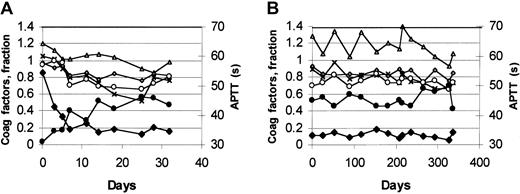Genetic predisposition may cause bleeding tendencies during treatment with oral anticoagulation (OAC) in some patients. Recently, mutations in the propeptide of coagulation factor IX (FIX) were discovered,1,2 leading to warfarin hypersensitivity and repeated bleeding episodes in spite of therapeutic or even subtherapeutic international normalized ratio (INR) levels during treatment with vitamin K antagonists. FIX levels decrease much more than the other vitamin K–dependent coagulation factors II, VII, and X, and a disproportionately prolonged activated partial thromboplastin time (APTT) is seen. Genetically, a single guanosine-to-adenosine transition at nucleotide 6346 (6346G>A) or a cytosine-to-thymine transition at nucleotide 6347 (6347C>T) have been described,1,2 which result in an alanine-to-threonine or alanine-to-valine change, respectively, at residue −10 (Ala−10Thr or Ala−10Val) in the propeptide of FIX leading to reduced affinity of the γ-glutamylcarboxylase.1 Treatment with vitamin K antagonists is considered to be contraindicated because of the severe bleeding complications.3 4 However, we have treated a patient with the propeptide mutation successfully for 5 years with warfarin necessitated by the presence of a prosthetic mechanical aortic valve, which had been inserted because of endocarditis complicated with insufficiency of the aortic valve at an age of 62 years. The patient has given informed consent to publish the case story.
After the operation, treatment with OAC (phenprocoumon) was started, but the the patient had bleeding episodes in the muscles in spite of an INR in therapeutic range. A markedly prolonged APTT was found (128 seconds; reference values, 28-41 seconds), and analysis of coagulation factors showed a very low FIX level of 4% at an INR level of 1.9 (prothrombin time, 30%). The patient was wrongly considered to have hemophilia B, and an attempt at monitoring treatment by APTT as well as INR was made, but due to several bleedings during the following months the treatment was replaced by acetyl salicylic acid (ASA). During this treatment FIX level normalized. Three years later, however, the patient had cerebral thrombosis, acute myocardial infarction, and a transient ischemic attack, all within a 6-month period. The propeptide mutations of FIX had now been published1,2 and analysis of DNA showed that the patient had the 6346G>A. In spite of the various diseases, the patient was in very good shape with few sequelae, and because ASA obviously was insufficient to avoid thromboembolism, treatment with warfarin monitored by measurement of FIX activity was now attempted. Because patients with hemophilia B seldom get thromboses,5 a therapeutic interval of 10% to 20% was chosen, corresponding to hemophilia B patients at a level with only a minor bleeding tendency. Figure1A shows that the decrease of FIX is much faster than the other factors during initiation of OAC. Proteins C and S also decreased just slightly within the reference intervals. The treatment was combined with 100 mg ASA every second day because combination therapy has been found to be beneficial,6 but because the patient had 4 episodes of gastrointestinal bleedings during the following 2 years, ASA was stopped and the therapeutic range for FIX was lowered to 8% to 16%. During the last 3 years neither bleedings nor thromboses have occurred. Figure 1B shows the factors during 1 year of treatment; INR levels have been 1.1 or 1.2. Small changes in dosage may have a major effect on FIX level; the present dosage is 2.5 mg daily plus 0.63 mg (a quarter of a tablet) each fourth day. The patient was monitored frequently in the beginning but now an examination is usually performed monthly.
Time course of coagulation factors during warfarin therapy.
The concentration of coagulation factors II (⋄), VII (▵), IX (♦), and X (×), and prothrombin time (○), and APTT (●) during initiation of warfarin treatment (A; “0 days” is at the start of treatment), and during one year of stable treatment (B; “0 days” is simply at the start of this period) in a patient with FIX propeptide mutation. The activity of the various coagulation factors and the prothrombin time are described as a fraction of 1.0; ie, 1.0 = 100%.
Time course of coagulation factors during warfarin therapy.
The concentration of coagulation factors II (⋄), VII (▵), IX (♦), and X (×), and prothrombin time (○), and APTT (●) during initiation of warfarin treatment (A; “0 days” is at the start of treatment), and during one year of stable treatment (B; “0 days” is simply at the start of this period) in a patient with FIX propeptide mutation. The activity of the various coagulation factors and the prothrombin time are described as a fraction of 1.0; ie, 1.0 = 100%.
Thus, patients with a FIX propeptide mutation can be treated with warfarin using analysis of FIX activity to monitor the treatment. Dosing must be performed cautiously, but in spite of the hypersensitivity to warfarin, FIX can be adjusted to a rather stable level with a suggested therapeutic goal of 8% to 16%.


This feature is available to Subscribers Only
Sign In or Create an Account Close Modal